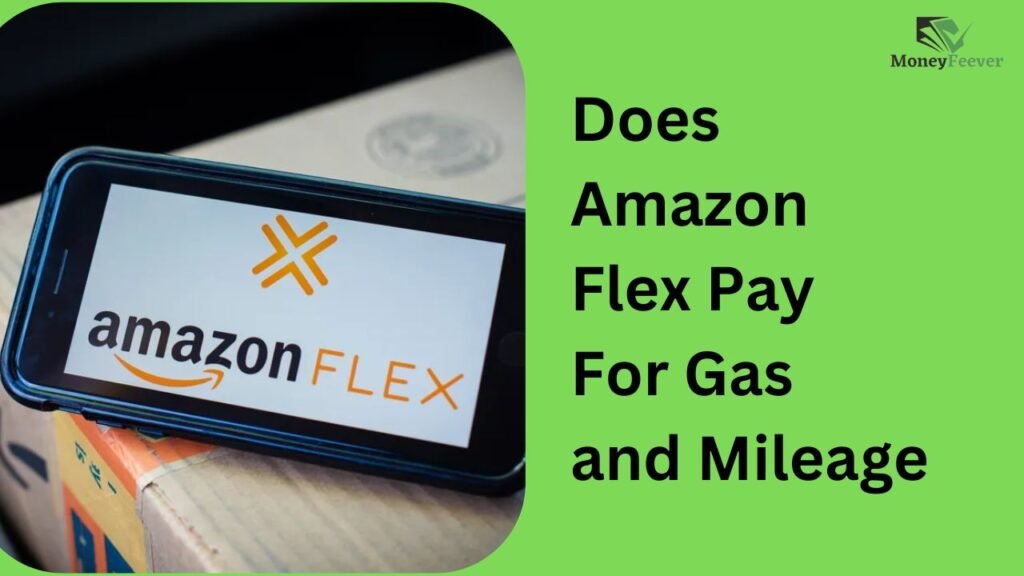Ever wondered if Amazon Flex covers gas and mileage? You’re not alone. Many people considering Amazon Flex, often have questions regarding fuel, repair, and many other expenses.
If you are concerned about these issues, don’t worry! We’ve answered your questions and offered some additional recommendations to help you save even more money when working with Amazon Flex.
So, let’s dive right in!

Does Amazon Flex Pay For Gas?
One of the most significant expenses drivers face while working for Amazon Flex is gas. Many individuals want to know, ‘Does Amazon Flex pay for gas?’ The clear answer to this question is no; Amazon Flex does not pay for gas.
Amazon Flex operates differently from some delivery firms that provide company vehicles or directly reimburse for gas expenses. Unlike them, Amazon Flex drivers are responsible for their own gasoline bills. While this may seem like a disadvantage, Amazon Flex compensates drivers in other ways, which we’ll explain later.
Hence, If you are an Amazon Flex driver or want to become it, you’ll have to pay for gas and other costs related to your job as well as your vehicle.
However, there are many other apps and platform that follow the same polices of not paying for gas such as, DoorDash, Instacart, and other apps related to delivering packages, as each platform hires an independent contractor.
Instead of gas expenses, Amazon Flex can only pay for the blocks you select to deliver products. Which is deposited directly into your bank account.
Why Pay for the Gas Matters for Amazon Flex drivers?
Working on platforms like Amazon Flex requires expenses in which gas costs can considerably reduce your income. Keeping track of your expenses helps to know how much you earn and spend on your job.
1. Narrating True Gains
Amazon Flex offers lucrative earning opportunities, ranging from $18 to $25 per hour.
However, gas expenses can significantly impact overall earnings. Utilize mileage tracking apps like Rydoo or Everlance to monitor mileage and gas expenses efficiently. Keep meticulous records of gas purchases to accurately assess net income.
2. Efficient Route Planning
Inefficient route planning can lead to increased fuel consumption and decreased earnings.
Optimize routes by selecting the shortest and most direct paths between delivery locations.
Group packages in close proximity to minimize stops and starts, reducing fuel usage.
Prioritize efficient route planning to maximize earnings potential.
3. Tax Return Implications
Understand the tax implications associated with being an Amazon Flex driver.
Gas and mileage expenses are tax-deductible, allowing drivers to claim deductions and protect more income. Consult with a tax professional to ensure accurate filing and maximize deductions.
Note the IRS mileage deduction rate, which was $0.655 per mile in 2023, but verify current rates for accurate tax planning.
If you want more explanation, check the video given below
Do Other Gig Apps Pay Delivery Drivers For Gas?
You may know that other delivery drivers have to pay for gas too. Every individual who works on such gig platforms has the same scenario. As they work as an independent driver who has to take responsibility for all expenses related to their job and gas.
Simply because these platforms such as Amazon Flex, DoorDash, or Uber Eats don’t pay for gas expenses, doesn’t mean they are not a good option for a side hustle to generate a source of income.
If you track your expenses and make sure of some points we’ll unpack below, you can live happily with your job, and eventually, you’ll know that the earnings are always much higher than the costs you worry about.
Now, this is important
How can Amazon Flex Drivers Save Money On Gas
Knowing that you have to pay for gas seems shocking. However, If you consider these things, you can save more money on gas than you were saving before.
1. Use Amazon Flex Card
Want to get cashback on every spend you make on fuels? If so, getting an Amazon Flex Card can be a bargain decision for you.
As it sounds like, this card is specifically designed for Amazon Flex Drivers like you, to take maximum benefit of it.
This is a kind of debit card that lets you save up to 6% on fuel costs, which can be added to a significant amount of income if you use it regularly. On the other hand, If you use it on the food market and Amazon, you’ll get 2% cashback on each such purchase you make.
2. Drive A Fuel Efficient Car
On working with Amazon Flex, you decide on which vehicle you’ll deliver packages, it’s the best perk on this platform. Hence, choose a vehicle that’s capable of saving fuel and providing excellent work with less gas consumption such as cars, minivans, etc.
In case of if you can’t find a fuel-efficient car, there may be some flex drivers in your city. You can use their vehicle as a rental and pay for it after completion of work, but importantly make sure to have the income to cover renting fees and other expenses related to your job.
3. Select Blocks Wisely
Selecting blocks that pay higher than often, can save a significant amount on gas. Usually, by choosing Amazon Flex Blocks people get paid from $18 to $25 an hour.
While some flex drivers claim that they get up to $50 an hour or more.
The reason why prices vary is due to the demand of drivers changing. When you attend a job during holidays, or seasons that provoke people to order more products online. You typically get a quite higher price than most of the time.
To get these blocks, utilize a feature on Amazon Flex called “Preferred Scheduling“, this perk is only for level two or more flex drivers.
If you are not at this level, make a priority of gathering points as much as you can. When you pick a block and complete it, you enhance your level.
When you achieve level two or more, you’ll unlock the preferred scheduling feature, and get a higher price block after setting it.
4. Use Different Gigs
Amazon Flex is a great gig opportunity to make money delivering packages. While, when some people are stuck on the Flex waiting list or have to pay for gas, they want to try different jobs like Amazon Flex.
Additionally, flex jobs require big vehicles that increase gas costs. Hence, it may be a good decision for you to take different jobs such as GrubHub, Instacart, etc. On these platforms you can start your work with smaller vehicles such as a bike, that won’t cost you significant money on gas.
Eventually, you’ll no longer have to worry about gas expenses if you prefer to work on other jobs, but to get the best salary, other jobs might not pay like Amazon Flex does.
5. Use Gas Price Comparison Apps
Take advantage of gas price comparison apps or websites to find the lowest fuel prices in your area. By filling up at cheaper gas stations, you can save money on each tank of gas.
6. Consider Carpooling or Ride-Sharing
If you have fellow Amazon Flex drivers in your area, consider carpooling or ride-sharing to split gas costs. Sharing rides with others can help reduce individual fuel expenses and save money collectively.
7. Monitor Tire Pressure
Keep your vehicle’s tires properly inflated to the recommended pressure levels. Under-inflated tires can increase rolling resistance, leading to higher fuel consumption. Regularly check tire pressure and inflate tires as needed to optimize fuel efficiency.
8. Track Gas Expenses
Keep detailed records of gas expenses and monitor your fuel consumption over time. By tracking gas expenses, you can identify patterns and make adjustments to optimize fuel efficiency further.
9. Utilize Fuel Rewards Programs
Sign up for fuel rewards programs offered by gas stations or grocery stores. These programs often provide discounts or cashback on fuel purchases, helping you save money over time.
10. Plan Efficient Routes
Plan delivery routes strategically to minimize driving distance and maximize efficiency. Group deliveries in the same area to reduce unnecessary driving between locations. Utilize GPS navigation apps that offer route optimization features to help plan the most efficient routes.
The Bottom Line
We suppose you have got your answer. Put simply, Amazon Flex doesn’t pay for gas and mileage. Because you work as an independent contractor, you’ll have to lift the responsibility of every expense that comes with your job. However, If you conceive some tactics we discussed earlier, you can save your hard-earned money from gas costs.
Moreover, keeping track of your expenses is another game that I want you to win. By using some apps you can track your mileage, help planning routes and also protect your income on filing taxes.
Frequently Asked Questions
Does Amazon Flex Pay Daily?
Yes, Amazon Flex pays daily. It let drivers prefer when to receive payment.
Does Amazon Flex Pay for Tolls?
Nope, Amazon Flex doesn’t pay for trolls, because flex drivers work as independent contractors.
Can You Make A Living Off Amazon Flex?
No, you can’t make a living off Amazon Flex, because it’s difficult to get blocks every time you are ready.
What Is Amazon Flex Average Miles Per Block?
Amazon Flex Average miles per block is around 80 to 100 miles, in case of 4 hours block.
Is Amazon Flex Worth It With Gas Prices?
Yes, Amazon Flex is worth it with gas prices.
